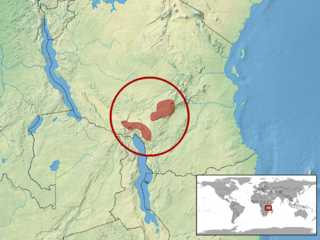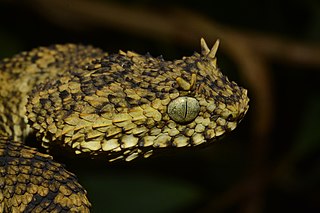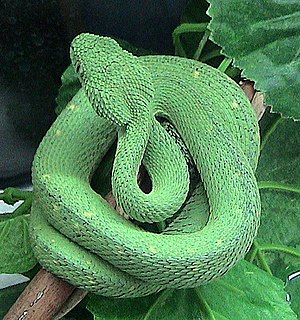Matilda or Mathilda may refer to:

Cerastes cerastes, commonly known as the Saharan horned viper or the desert horned viper, is a venomous species of viper native to the deserts of northern Africa and parts of the Arabian Peninsula and Levant. It often is easily recognized by the presence of a pair of supraocular "horns", although hornless individuals do occur. Three subspecies have been described.

Bothriechis schlegelii, known commonly as the eyelash viper, is a species of venomous pit viper in the family Viperidae. The species is native to Central and South America. Small and arboreal, this species is characterized by a wide array of color variations, as well as the superciliary scales above the eyes. It is the most common of the green palm-pitvipers, and is often present in zoological exhibits. The specific name schlegelii honors Hermann Schlegel, who was a German ornithologist and herpetologist. For other common names see below. No subspecies are currently recognized as being valid.

Field's horned viper, Pseudocerastes fieldi, is a venomous viper species endemic to the deserts of the Middle East. It was previously considered a subspecies of the Persian horned viper. The main differences between this species and the Persian horned viper are in scalation and venom composition.

Atheris squamigera is a viper species endemic to west and central Africa. No subspecies are currently recognized. Like all vipers, the species is venomous.

Atheris is a genus of venomous vipers known as bush vipers. They are found only in tropical subsaharan Africa and many species have isolated and fragmented distributions due to their confinement to rain forests. In an example of convergent evolution, they show many similarities to the arboreal pit vipers of Asia and South America. Seventeen species are currently recognized.

Atheris barbouri is a small and rare terrestrial species of viper endemic to the Uzungwe and Ukinga mountains of south-central Tanzania in Africa. No subspecies are recognized.
Proatheris is a monotypic genus created for the venomous viper species, Proatheris superciliaris. This is a small terrestrial species endemic to East Africa. No subspecies are currently recognized.

Atheris ceratophora is a venomous viper species endemic to a few mountain ranges in Tanzania. This used to be the only horned, arboreal viper known from Africa, until the discovery in 2011 of Atheris matildae, also found in Tanzania. No subspecies are currently recognized.

Atheris chlorechis is a venomous viper species found only in the forests of West Africa. No subspecies are currently recognized.

Atheris desaixi, commonly known as the Mount Kenya bush viper, Ashe's bush viper, or Desaix's bush viper, is a venomous species of viper endemic to Kenya, where only two isolated populations are known. It is known for its striking black and yellow coloration. No subspecies are currently recognized.

Atheris hispida is a venomous viper species endemic to Central Africa. It is known for its extremely keeled dorsal scales that give it a bristly appearance. No subspecies are currently recognized. Common names include rough-scaled bush viper, spiny bush viper, hairy bush viper, and more.

Atheris nitschei is a species of highly venomous snake, a viper in the subfamily Viperinae of the family Viperidae. The species is native to Africa. There are no subspecies that are recognized as being valid.

Cerastes gasperettii, commonly known as the Arabian horned viper, is a venomous viper species found especially in the Arabian Peninsula and north to Israel, Iraq, and Iran. It is very similar in appearance to C. cerastes, but the geographic ranges of these two species do not overlap. No subspecies of C. gasperettii are recognized.

The rhino-horned lizard, also commonly known as Stoddart's unicorn lizard and the mountain horned agama, is a species of lizard in the family Agamidae. The species is endemic to Sri Lanka. It is called kagamuva angkatussa-කගමුව අං කටුස්සා in Sinhala.

Mount Mabu is a mountain in northern Mozambique, famous for its old-growth rain forest. Mount Mabu is approximately 1,700 metres high and the forest covers about 7,000 hectares. While well known locally, the Mount Mabu forest and its extremely diverse wildlife were unknown to plant and animal scientists until 2005. It was visited after browsing Google Earth in 2005 by a team of scientists from the Mulanje Mountain Conservation Trust (MMCT) and several ornithologists, and later in 2008 by scientists from Kew Royal Botanic Gardens; by browsing Google Earth's satellite view to look for potential unknown wildlife hotspots in Africa. It is frequently referred to as the "Google Forest".

(TANAPA))
Atheris mabuensis, the Mount Mabu forest viper, is a species of venomous snake in the family Viperidae. It is endemic to Mozambique.













